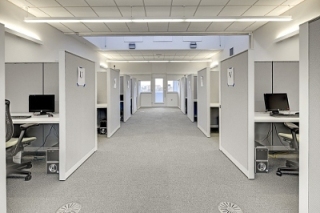Oct 27 2015
Improved indoor environmental quality doubled participants' scores on cognitive function tests, according to a new study by researchers at the Harvard University T.H. Chan School of Public Health's Center for Health and the Global Environment, SUNY Upstate Medical University and Syracuse University. Primary support for the study came from United Technologies (NYSE: UTX) and its UTC Climate, Controls & Security business.
 Study participants' cognitive function was measured daily within the environmentally controlled space at the Total Indoor Environmental Quality Laboratory at the Syracuse Center of Excellence.
Study participants' cognitive function was measured daily within the environmentally controlled space at the Total Indoor Environmental Quality Laboratory at the Syracuse Center of Excellence.
"The Impact of Green Buildings on Cognitive Function" study found that employees' cognitive performance scores averaged 101 percent higher in green building environments with enhanced ventilation compared to a conventional building environment.
"When it comes to the decision-making ability of green building occupants, intelligence is in the air," said John Mandyck, United Technologies Chief Sustainability Officer. "We know green buildings conserve natural resources, minimize environmental impacts and improve the indoor environment, but these results show they can also become important human resource tools for all indoor environments where cognitive abilities are critical to productivity, learning and safety.
"The payback for improved indoor environmental quality far outweighs the investment, considering that more than 90 percent of the costs associated with a building are related to the people who work within it once construction is completed," he added.
The double-blind study evaluated the cognitive performance of 24 participants who experienced conditions in a laboratory setting that simulate those found in conventional and green buildings, as well as green buildings with enhanced ventilation. Researchers measured cognitive function for nine functional domains, including basic, applied and focused activity levels; task orientation; crisis response; information seeking; information usage; breadth of approach; and strategy.
The largest improvements in cognitive function test scores occurred in the areas of crisis response, information usage and strategy.
- Crisis response scores were 97 percent higher for the green environment and 131 percent higher for the green environment with enhanced ventilation and lower carbon dioxide levels compared to the conventional environment.
- Information usage scores for green and enhanced green environments were 172 and 299 percent higher than in the conventional environment, respectively.
- For strategy, green and enhanced green scores were 183 and 288 percent higher than the conventional environment.
"This study suggests that indoor environments can have a profound impact on the decision-making performance of workers, which is a primary indicator of worker productivity," said Dr. Joseph Allen, Assistant Professor of Exposure Assessment Science at the Harvard T.H. Chan School of Public Health, Director of the Healthy Buildings Program at the Center for Health and the Global Environment at Harvard Chan School, and Principal Investigator for the study. "These results are provocative for three reasons. First, they suggest that the levels of carbon dioxide and volatile organic compounds that we commonly encounter in conventional office buildings are associated with decreases in worker performance compared to when those same workers are in green building environments. Second, when we enhance ventilation and optimize indoor environmental conditions, we see improvements in the cognitive function of workers. And third, these results fill important knowledge gaps in existing research about the relationship between green buildings and occupant health."
The study was conducted in the environmentally controlled, world-class Total Indoor Environmental Quality Laboratory at the Syracuse Center of Excellence in Environmental and Energy Systems in Syracuse, New York, and took place over the course of six workdays spread across a two-week period.
"Participants spent each day during the test period conducting their normal work activities in indoor environments that are encountered every day by large numbers of workers," said Dr. Suresh Santanam, Associate Professor of Biomedical and Chemical Engineering at Syracuse University and study co-investigator. "Because of the controlled way in which the study was designed and conducted within the state-of-the-art lab, we're confident of the results, which are very significant."
At the end of each six-hour workday, participants completed a 1.5 hour cognitive assessment using a well-validated, computer-based cognitive assessment test. "The Strategic Management Simulation evaluates decision-making and has been used by more than 70,000 participants worldwide over the last seven decades," said Dr. Usha Satish, Professor of Psychiatry and Behavioral Sciences, SUNY Upstate Medical University and study co-investigator. "It gives participants the freedom to make decisions based on their own cognitive styles and is reflective of their performance in the real world. The gains in performance output under conditions of improved indoor environments could be seen in areas such as the handling of day-to-day workplace challenges, where they were better able to understand and use their resources with optimal task prioritization."
The Center for Health and the Global Environment at the Harvard Chan School and SUNY Upstate Medical are launching a second phase of research, which will move from the lab into real buildings across the United States. This research will also be supported by a gift from United Technologies.